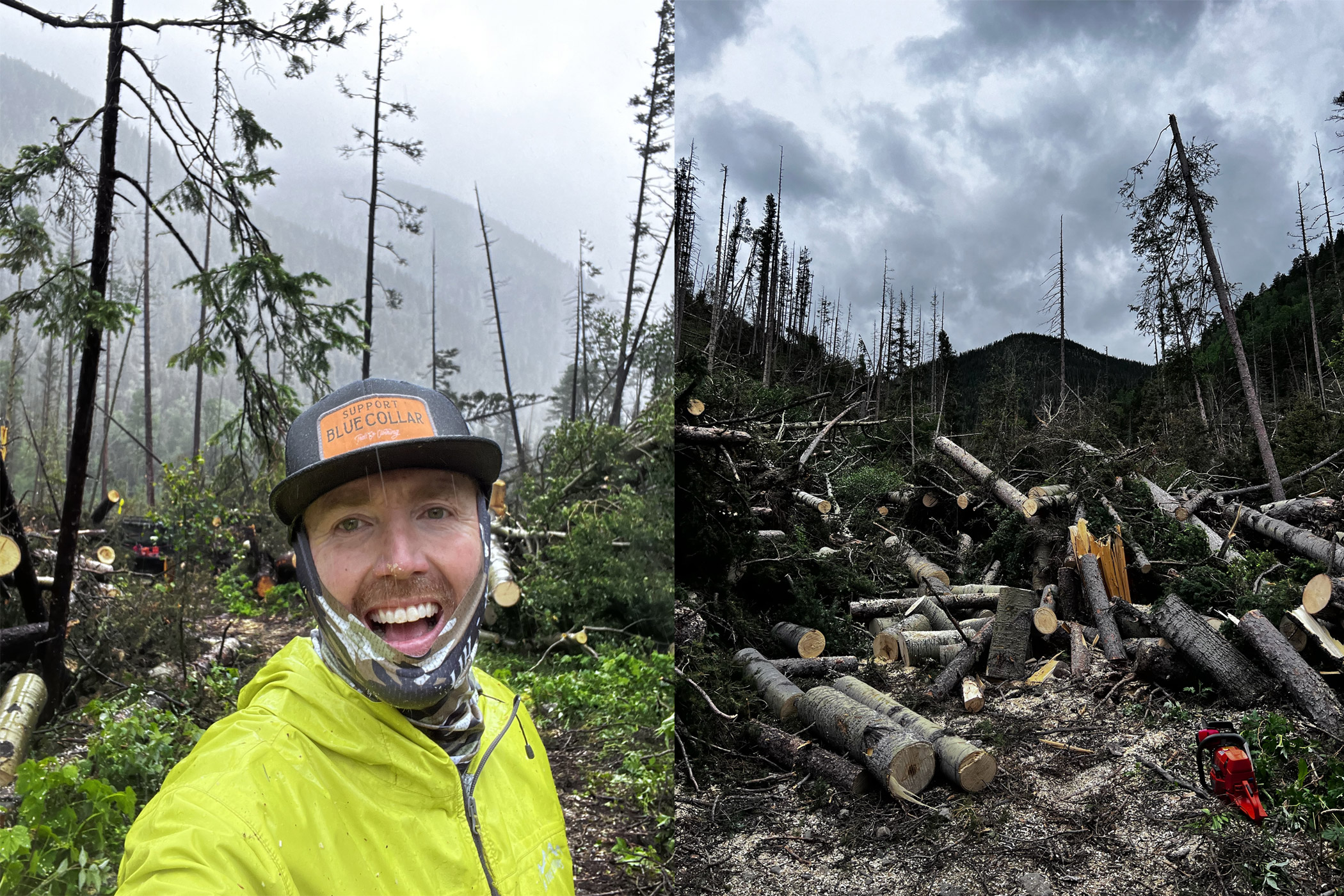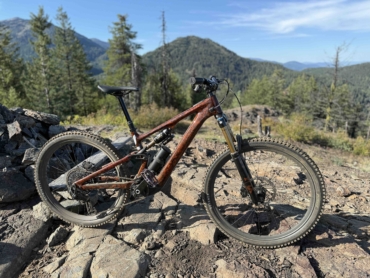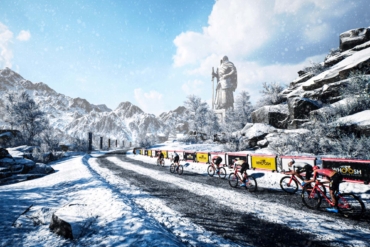In every photo, Justin Brandenburg is grinning. He doesn’t look like he’s grinding through a seemingly insurmountable task. But that’s exactly what he was doing. As he snapped those smiling selfies, he was single-handedly clearing miles of trail of blown-down trees.
Some were stacked 20 feet high like massive jumbles of toothpicks. They were blocking a trail that climbs from a creekside trailhead through a pine forest and along airy drop-offs in boulder fields to a place called Lost Lake. Brandenburg loves it there. It’s his favorite trail and he wasn’t about to spend a summer without it.
“People asked me if it was like work, but for me, it’s a feeling of self-accomplishment,” Brandenburg told GearJunkie over the phone while snowmobiling in Idaho. He’d paused in a meadow ringed by snowy trees for the interview.
“There isn’t a better place to be than in the mountains — by yourself. And I knew that when I went out there every day, I was accomplishing something,” he said. “And it was fun. It was just as much fun to go out and do that as it was to get on my mountain bike.”
Clearing Trees: 2021’s Winter Storm

Brandenburg was clearing the wreckage left after a December 2021 snow squall swept through northern New Mexico. Winds of more than 100 mph slammed into the Sangre de Cristo Mountains.
“The wind seemed to shoot through these valleys and just keep building momentum,” said Adam LaDell, the local district ranger for the Carson National Forest.
Overall, the storm flattened just 7,000 acres — pockets of the 1.5-million-acre national forest. But it hit some of the most popular places in the region. Trees tangled over ski runs and lifts at Taos Ski Valley and Red River Ski Area, smashed houses in the deliberately quaint town of Red River, and obliterated hiking and mountain biking trails in the national forest.
Several wilderness areas were inaccessible. Trees buried the trails to reach them, demanding hikers and bikers climb over, crawl under, or loop far around to search through the deadfall for traces of a trail to follow.
The Aftermath

An estimated 11,000 trees needed clearing to reopen those trails. Often, crews of volunteers showed up and busted out their work gloves — the community came together for public lands, as LaDell described. Then, there was Brandenburg, out by himself. Or, at best, with a couple of other people for about one week of the 3 he dedicated to clearing roughly 950 trees.
“Those are areas that I love to ride my bike. So it was partially selfish intentions, because it’s my favorite place to go,” Brandenburg said. “And because I wanted it to be better for other people.”
He chose to salvage the local trails to Middle Fork Lake and Lost Lake that were some of the first he pedaled when he started mountain biking a decade ago. He still rides there twice a week, logging about 1,000 miles on trail each summer, seeking out a little quiet.
“Side by sides, the UTVs, are a huge part of our tourism. But being a mountain biker and hiker, they’re super annoying,” he said. So, he seeks out an area open only to hikers, bikers, and horseback riders. There, he said, “I could go and get away from all of it — all the noise and commotion.”
More Than Just Trails
Brandenburg has spent more than 3 decades recreating in the woods around northern New Mexico. He grew up there, left for college, then came home, working as a carpenter for a time. Now he runs a couple of gift shops, Climates and Gold Nugget, with his wife, and manages All Seasons, one of the local ski shops, in the winter.
He can count back five generations to a great-great-grandfather who helped found the town of Red River. The town’s wooden, Old West-influenced storefronts and ski runs nearly pour onto the main street and the city park that hosts concerts in summers.
“The cliché is that we’re like a Hallmark movie, but we are,” he said. “We’re 460 people in one of the most leftover nuggets in the world. We’re pretty untouched by most everything that goes on around the world.”
He knew two things to be true about the damage from that December 2021 storm. Tourism pays for everything. And if the trails were closed, tourists might not come. And the Forest Service was already short-staffed and working with tight resources. He knew these projects might barely crawl toward completion without outside help.
“I felt like they had other things they could be concerned with, and I could be concerned with that little bit,” Brandenburg said. “I felt like mine was pretty small though in the scope of what forestry departments have to deal with. Especially with the largest fire in our state burning super close.”
The Carson National Forest would spend the spring facing down the Hermits Peak/Calf Canyon wildfire, the largest in New Mexico’s history. Then it worked to recover burn-scarred areas that totaled more than 340,000 acres. Without volunteers, removing trees from trails so hikers and bikers could travel them without suffering through a woodsy jungle gym simply would not have happened.
As it was, Brandenburg had to wait for the national forest to lift a ban on the public. After wildfires took off this spring, forest managers barred visitors from national forests across the state. State parks and even city open spaces were likewise closed as extreme fire danger spread. Any spark — an ashed cigarette, a vehicle parked on dry grass, even a bike pedal striking a rock — could have started another fire.
Then, rain began falling in June. As soon as the forest reopened, Brandenburg was hiking in with a chainsaw.

Chainsaw in Hand: The Work Begins Clearing Trees
The trail he started up begins with crossing a river. Then it turns uphill on an initially gentle slope to a waterfall, where the stacked switchbacks start. After rounding that first corner, Brandenburg said gusts had downed trees like rows of dominoes.
“I had no idea how bad it was,” he said, “The first day I went, I was sad and overwhelmed by the whole devastation of the area.”
Trees had fallen so one was effectively pinning down another, making for a dangerous puzzle. Cutting one might free another to swing or slip. He’d stare at the tangle long enough to visually untie it, then start cutting trunks into 4-foot pieces he could lift away.
Once, he sawed a tree loose from its knot of roots and the trunk rolled and nearly crushed him.
“The first 3 or 4 days was the learning process — how do I approach this? What’s the best way to climb up on all these downed trees safely with a chainsaw?” he said. “Then, it became not easy, but definitely easier.”
As much as he could, he steered pieces to support the trail. Brandenburg removed root balls blocking drainages and flooding the trail. He aimed chunks of trees so they’d obscure social trails or shortcuts fueling erosion. Some of the trees were enormous, perhaps 180 feet tall and 4 feet in diameter.
“Some of those trees have been around a long time,” he said. “For them to go away is kind of a bummer.”

The Forest Service gave him permission to drive a side-by-side as far up the trail as it would fit — which wasn’t far. But it spared him from having to rehike every mile he’d already cleared before starting the day’s work. Still, Brandenburg often had to hike an hour or two to pick up where he left off clearing trees the day before. Then he’d spend another few hours cutting through trees.
Since he works for himself in summer, his “boss” could grant him the flexibility to go up day after day. Sometimes, people hiked past him. They would return in half an hour or so, spit back by the impenetrable wall, and report, “It just gets worse.”
To which he’d reply, “That’s what I figured.”

He Never Once Thought of Giving Up
“There wasn’t the pressure of, ‘Someone is paying me to do this, that I have a responsibility to get this done for a greater entity,'” he said. “It was merely, ‘I’m going out and I’m going to do this because I want to ride my bike up here.’ Every day, I would count out, like, I made it six switchbacks, it’s 22 to the lake. I’m going to get there.”

By July, the trails were clear, and Brandenburg was heading out to ride. As he pedaled, he’d sometimes see more people hiking there in a single afternoon than he’d seen over entire summers in years past. As word spread about the work he’d put in, people sent him messages on Facebook, or came by the store to tell him how much they appreciated it or to leave thank you cards.
In October, the Forest Service recognized him at a ceremony celebrating the volunteer work done this year. And that’s when his eyes turned toward what’s next.
Forest Service crews made it about 2 miles up a nearby trail that loops into the trails he’d cleared but didn’t finish. This spring, Brandenburg said, he’ll head for that section. He’d really like to have that loop back too.
“There isn’t some great, divine statement,” he said. “I just did it because that’s where I like to go and spend my time.”







